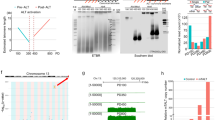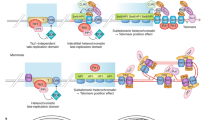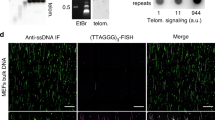Abstract
Telomeres of eukaryotic chromosomes contain many tandem repeats of a G-rich sequence (for example, TTAGGG in vertebrates1). In most normal human cells, telomeres shorten with each cell division, and it is proposed that this limits the number of times these cells can replicate2. Telomeres may be maintained in germline cells, and in many immortalized cells and cancers, by the telomerase holoenzyme3 (first discovered in the ciliate Tetrahymena4), which uses an RNA subunit as template for synthesis of telomeric DNA by the reverse transcriptase catalytic subunit5. Some immortalized human cell lines and some tumours maintain their telomeres in the absence of any detectable telomerase activity by a mechanism referred to as alternative lengthening of telomeres6,7 (ALT). Here we show that DNA sequences are copied from telomere to telomere in an immortalized human ALT cell line, indicating that ALT occurs by means of homologous recombination and copy switching.
This is a preview of subscription content, access via your institution
Access options
Subscribe to this journal
Receive 12 print issues and online access
$209.00 per year
only $17.42 per issue
Buy this article
- Purchase on Springer Link
- Instant access to full article PDF
Prices may be subject to local taxes which are calculated during checkout




Similar content being viewed by others
References
Blackburn, E.H. Structure and function of telomeres. Nature 350, 569–573 (1991).
Olovnikov, A.M. A theory of marginotomy. The incomplete copying of template margin in enzymic synthesis of polynucleotides and biological significance of the phenomenon . J. Theor. Biol. 41, 181– 190 (1973).
Shay, J.W. & Bacchetti, S. A survey of telomerase activity in human cancer. Eur. J. Cancer 33A, 787–791 (1997).
Greider, C.W. & Blackburn, E.H. Identification of a specific telomere terminal transferase activity in Tetrahymena extracts. Cell 43, 405– 413 (1985).
Colgin, L.M. & Reddel, R.R. Telomere maintenance mechanisms and cellular immortalization. Curr. Opin. Genet. Dev. 9, 97–103 ( 1999).
Bryan, T.M., Englezou, A., Gupta, J., Bacchetti, S. & Reddel, R.R. Telomere elongation in immortal human cells without detectable telomerase activity. EMBO J. 14, 4240–4248 (1995).
Bryan, T.M., Englezou, A., Dalla-Pozza, L., Dunham, M.A. & Reddel, R.R. Evidence for an alternative mechanism for maintaining telomere length in human tumors and tumor-derived cell lines. Nature Med. 3, 1271– 1274 (1997).
Mason, J.M. & Biessmann, H. The unusual telomeres of Drosophila. Trends Genet. 11, 58–62 (1995).
Roth, C.W., Kobeski, F., Walter, M.F. & Biessmann, H. Chromosome end elongation by recombination in the mosquito Anopheles gambiae . Mol. Cell. Biol. 17, 5176– 5183 (1997).
Lundblad, V. & Szostak, J.W. A mutant with a defect in telomere elongation leads to senescence in yeast. Cell 57, 633–643 (1989).
Lundblad, V. & Blackburn, E.H. An alternative pathway for yeast telomere maintenance rescues est1− senescence. Cell 73, 347– 360 (1993).
McEachern, M.J. & Blackburn, E.H. Cap-prevented recombination between terminal telomeric repeat arrays (telomere CPR) maintains telomeres in Kluyveromyces lactis lacking telomerase. Genes Dev. 10, 1822–1834 ( 1996).
Lendvay, T.S., Morris, D.K., Sah, J., Balasubramanian, B. & Lundblad, V. Senescence mutants of Saccharomyces cerevisiae with a defect in telomere replication identify three additional EST genes. Genetics 144, 1399–1412 (1996).
Teng, S.-C. & Zakian, V.A. Telomere-telomere recombination is an efficient bypass pathway for telomere maintenance in Saccharomyces cerevisiae. Mol. Cell. Biol. 19, 8083–8093 (1999).
Niida, H. et al. Telomere maintenance in telomerase-deficient mouse embryonic stem cells: Characterization of an amplified telomeric DNA. Mol. Cell. Biol. 20, 4115–4127 (2000).
Yeager, T.R. et al. Telomerase-negative immortalized human cells contain a novel type of promyelocytic leukemia (PML) body. Cancer Res. 59, 4175–4179 (1999).
Reddel, R.R., Bryan, T.M. & Murnane, J.P. Immortalized cells with no detectable telomerase activity. A review. Biochemistry (Mosc.) 62, 1254– 1262 (1997).
Kass-Eisler, A. & Greider, C.W. Recombination in telomere-length maintenance. Trends Biochem. Sci. 25, 200–204 (2000).
Reddel, R.R. The role of senescence and immortalization in carcinogenesis. Carcinogenesis 21, 477–484 (2000).
Griffith, J.D. et al. Mammalian telomeres end in a large duplex loop. Cell 97, 503–514 ( 1999).
Murnane, J.P. & Yu, L.-C. Acquisition of telomere repeat sequences by transfected DNA integrated at the site of a chromosome break. Mol. Cell. Biol. 13, 977– 983 (1993).
Sprung, C.N., Sabatier, L. & Murnane, J.P. Telomere dynamics in a human cancer cell line. Exp. Cell Res. 247, 29–37 (1999).
Stout, K. et al. Somatic pairing between subtelomeric chromosome regions: implications for human genetic disease? Chromosome Res. 7, 323–329 (1999).
Teng, S.-C., Chang, J., McCowan, B. & Zakian, V.A. Telomerase independent lengthening of Saccharomyces telomeres occurs by an abrupt Rad50p dependent, Rif inhibited recombinational process. Mol. Cell 6, 947–952 (2000).
Walmsley, R.W., Chan, C.S.M., Tye, B.-K. & Petes, T.D. Unusual DNA sequences associated with the ends of yeast chromosomes. Nature 310, 157–160 ( 1984).
Colgin, L.M. et al. The hTERTα splice variant is a dominant negative inhibitor of telomerase activity. Neoplasia (in press).
Perrem, K. et al. Repression of an alternative mechanism for lengthening of telomeres in somatic cell hybrids. Oncogene 18, 3383–3390 (1999).
Hanish, J.P., Yanowitz, J.L. & de Lange, T. Stringent sequence requirements for the formation of human telomeres. Proc. Natl Acad. Sci. USA 91, 8861–8865 (1994).
Saxon, P.J., Srivatsan, E.S., Leipzig, G.V., Sameshima, J.H. & Stanbridge, E.J. Selective transfer of individual human chromosomes to recipient cells. Mol. Cell. Biol. 5, 140–146 ( 1985).
Acknowledgements
We thank T. Haaf for the panel of subtelomeric CEPH mega-YACs, and T. de Lange for plasmid pSXneo-1.6-T2AG3. Supported by a project grant from the National Health and Medical Research Council of Australia, the Carcinogenesis Fellowship of the New South Wales Cancer Council, and a scholarship of the Judith Hyam Memorial Trust Fund for Cancer Research.
Author information
Authors and Affiliations
Corresponding author
Rights and permissions
About this article
Cite this article
Dunham, M., Neumann, A., Fasching, C. et al. Telomere maintenance by recombination in human cells. Nat Genet 26, 447–450 (2000). https://doi.org/10.1038/82586
Received:
Accepted:
Issue Date:
DOI: https://doi.org/10.1038/82586
This article is cited by
-
Adaptive and Maladaptive Clonal Hematopoiesis in Telomere Biology Disorders
Current Hematologic Malignancy Reports (2024)
-
A pan-sarcoma landscape of telomeric content shows that alterations in RAD51B and GID4 are associated with higher telomeric content
npj Genomic Medicine (2023)
-
Signalling inhibition by ponatinib disrupts productive alternative lengthening of telomeres (ALT)
Nature Communications (2023)
-
Histone demethylase KDM2A is a selective vulnerability of cancers relying on alternative telomere maintenance
Nature Communications (2023)
-
Association of Telomere Length with Cognitive Impairment
Journal of Molecular Neuroscience (2023)



